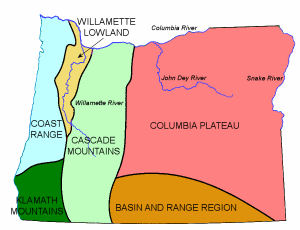
Oregon Land Regions
Oregon is known for its forests where about 1/10 of the nation's timber resides. In fact, Oregon is
the leading provider of lumber in the United States.
Oregon's geography can be divided into six areas; the Coast Range, the Willamette Lowland, the
Cascade Mountains, the Klamath Mountains, the Columbia Plateau, and the Basin and Range Region.
The Coast Range runs from north to south along the Pacific Ocean. Much of these low
mountain ranges are forested with evergreens such as Spruce, Fir, and Hemlock. The average
mountaintop in the Coast Range rises less than 2,000 feet above sea level, though Mary's Peak,
southwest of Corvallis, Oregon, reaches 4,097 feet above sea level. Along the coast, cliffs rise
almost 1,000 feet high over the Pacific Ocean. The Triangle Lake Valley was a very ancient lake.
Many small coastal lakes are scattered throughout the Coast Range.
The Willamette Lowlands are a narrow strip of land to the east of the Coast Range along
the Willamette River. The Willamette River flows north into the Columbia River. The soil is rich in
the Willamette Lowlands and the climate is mild.
To the east of the Willamette Lowlands, the Cascade Mountains rise to 11,239 feet above
sea level (Mount Hood). The Cascade Mountains provide a rugged landscape where many of the nation's
highest peaks can be found. Mount Hood is the highest point in Oregon. Other high peaks include Mt.
Jefferson at 10,497 feet above sea level, Three Sisters, over 10,000 feet above sea level, and Mount
McLoughlin, 9,495 feet high. Many lakes can be found in the Cascade Mountains. Crater Lake is the
deepest lake in the United States. It's 1,932 feet deep!
In the southwest corner of Oregon are the Klamath Mountains. The Klamath Mountains are
covered by dense forests.
Covering most of eastern Oregon and extending into Idaho and
Washington, is the Columbia Plateau. Thousands of years ago, the Columbia Plateau was formed
by lava flowing from cracks in the earth's crust. Oregon's Wheat farms are found on the Columbia
Plateau. Much of the Columbia Plateau is quite rugged, however, and mountains such as the Blue
Mountains and the Wallowa Mountains rise in the northeast. On the Oregon/Idaho border the Snake
River has cut Hells Canyon deep into the earth. The average depth of this gorge, located between the
Wallowa Mountains and the Seven Devils Mountains in Idaho, is 5,500 feet.
The Basin and Range Region covers a section of southeastern Oregon. The Basin and Range
Region in Oregon is marked by high basins and a few steep mountains. Much of this region is semi
desert.
( Oregon Close-up )
|




